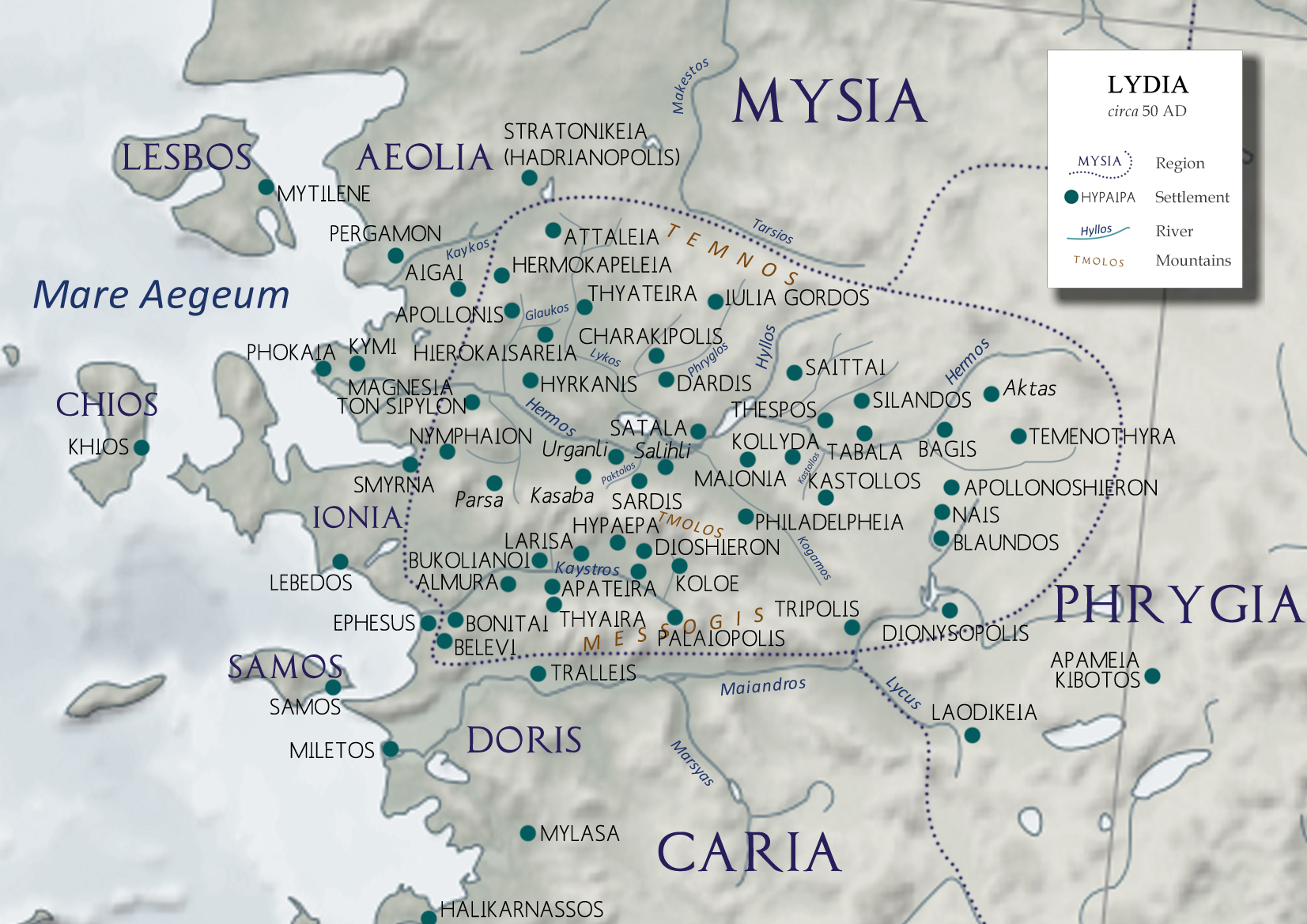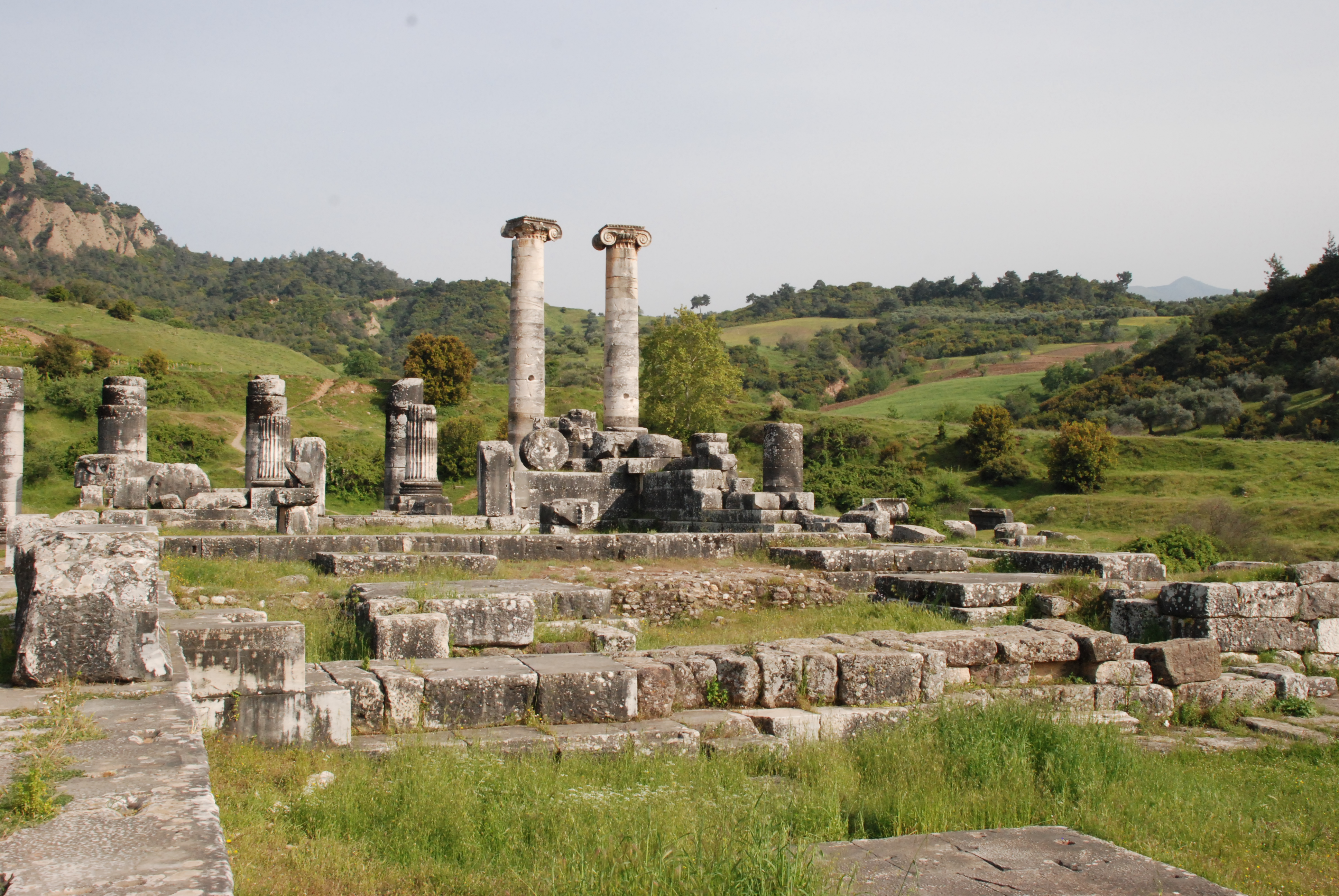|
Sardes
Sardis () or Sardes (; Lydian: 𐤳𐤱𐤠𐤭𐤣 ''Sfard''; el, Σάρδεις ''Sardeis''; peo, Sparda; hbo, ספרד ''Sfarad'') was an ancient city at the location of modern ''Sart'' (Sartmahmut before 19 October 2005), near Salihli, in Turkey's Manisa Province. Sardis was the capital of the ancient kingdom of Lydia, an important city of the Persian Empire, the seat of a Seleucid satrap, the seat of a proconsul under the Roman Empire, and the metropolis of the province Lydia in later Roman and Byzantine times. It is mentioned in the New Testament. Its importance was due first to its military strength, secondly to it being situated on an important highway leading from the interior to the Aegean coast, and thirdly to its commanding the wide and fertile plain of the Hermus. Geography Sardis was situated in the middle of Hermus valley, at the foot of Mount Tmolus, a steep and lofty spur which formed the citadel. It was about south of that Hermus. Today, the site is loc ... [...More Info...] [...Related Items...] OR: [Wikipedia] [Google] [Baidu] |
Lydia
Lydia ( Lydian: 𐤮𐤱𐤠𐤭𐤣𐤠, ''Śfarda''; Aramaic: ''Lydia''; el, Λυδία, ''Lȳdíā''; tr, Lidya) was an Iron Age kingdom of western Asia Minor located generally east of ancient Ionia in the modern western Turkish provinces of Uşak, Manisa and inland Izmir. The ethnic group inhabiting this kingdom are known as the Lydians, and their language, known as Lydian, was a member of the Anatolian branch of the Indo-European language family. The capital of Lydia was Sardis.Rhodes, P.J. ''A History of the Classical Greek World 478–323 BC''. 2nd edition. Chichester: Wiley-Blackwell, 2010, p. 6. The Kingdom of Lydia existed from about 1200 BC to 546 BC. At its greatest extent, during the 7th century BC, it covered all of western Anatolia. In 546 BC, it became a province of the Achaemenid Persian Empire, known as the satrapy of Lydia or ''Sparda'' in Old Persian. In 133 BC, it became part of the Roman province of Asia. Lydian coins, made of silver, are among the ... [...More Info...] [...Related Items...] OR: [Wikipedia] [Google] [Baidu] |
Croesus
Croesus ( ; Lydian: ; Phrygian: ; grc, Κροισος, Kroisos; Latin: ; reigned: c. 585 – c. 546 BC) was the king of Lydia, who reigned from 585 BC until his defeat by the Persian king Cyrus the Great in 547 or 546 BC. Croesus was renowned for his wealth; Herodotus and Pausanias noted that his gifts were preserved at Delphi. The fall of Croesus had a profound effect on the Greeks, providing a fixed point in their calendar. "By the fifth century at least," J. A. S. Evans has remarked, "Croesus had become a figure of myth, who stood outside the conventional restraints of chronology." Name The name of Croesus was not attested in contemporary inscriptions in the Lydian language. In 2019, D. Sasseville and K. Euler published a research of Lydian coins apparently minted during his rule, where the name of the ruler was rendered as ''Qλdãns''. The name comes from the Latin transliteration of the Greek , which was itself the ancient Hellenic adaptation of the Lydian na ... [...More Info...] [...Related Items...] OR: [Wikipedia] [Google] [Baidu] |
Salihli
Salihli is a large town and district of Manisa Province in the Aegean region of Turkey. Geography The city of Salihli, the seat of the district, is located on İzmir-Ankara (E 96) highway and the parallel railway connections. The urban zone is situated on the slopes of Bozdağ mountain chain along the southern alluvial plains of the Gediz River. To the north and northeast of the plain extend two other mountain ranges, respectively those of the mounts Dibek (highest altitude 1120 m) and Üşümüş (highest altitude 1085 m). The town lies at an altitude of 125 meters from the sea level. Its advantageous location, smooth and busy intercity connections and the fertile soil allowed Salihli to develop extremely well in the recent past. Four streams, namely Alaşehir, Gümüş, Kurşunlu and Sart cross the district area to join the River Gediz, which flows westward. The climate type is Mediterranean climate. To the north of the city is Demirköprü Dam, used for irrigation, preven ... [...More Info...] [...Related Items...] OR: [Wikipedia] [Google] [Baidu] |
Lydia Circa 50 AD - English Legend
Lydia ( Lydian: 𐤮𐤱𐤠𐤭𐤣𐤠, ''Śfarda''; Aramaic: ''Lydia''; el, Λυδία, ''Lȳdíā''; tr, Lidya) was an Iron Age kingdom of western Asia Minor located generally east of ancient Ionia in the modern western Turkish provinces of Uşak, Manisa and inland Izmir. The ethnic group inhabiting this kingdom are known as the Lydians, and their language, known as Lydian, was a member of the Anatolian branch of the Indo-European language family. The capital of Lydia was Sardis.Rhodes, P.J. ''A History of the Classical Greek World 478–323 BC''. 2nd edition. Chichester: Wiley-Blackwell, 2010, p. 6. The Kingdom of Lydia existed from about 1200 BC to 546 BC. At its greatest extent, during the 7th century BC, it covered all of western Anatolia. In 546 BC, it became a province of the Achaemenid Persian Empire, known as the satrapy of Lydia or ''Sparda'' in Old Persian. In 133 BC, it became part of the Roman province of Asia. Lydian coins, made of silver, are amon ... [...More Info...] [...Related Items...] OR: [Wikipedia] [Google] [Baidu] |
Turkey
Turkey ( tr, Türkiye ), officially the Republic of Türkiye ( tr, Türkiye Cumhuriyeti, links=no ), is a list of transcontinental countries, transcontinental country located mainly on the Anatolia, Anatolian Peninsula in Western Asia, with a East Thrace, small portion on the Balkans, Balkan Peninsula in Southeast Europe. It shares borders with the Black Sea to the north; Georgia (country), Georgia to the northeast; Armenia, Azerbaijan, and Iran to the east; Iraq to the southeast; Syria and the Mediterranean Sea to the south; the Aegean Sea to the west; and Greece and Bulgaria to the northwest. Cyprus is located off the south coast. Turkish people, Turks form the vast majority of the nation's population and Kurds are the largest minority. Ankara is Turkey's capital, while Istanbul is its list of largest cities and towns in Turkey, largest city and financial centre. One of the world's earliest permanently Settler, settled regions, present-day Turkey was home to important Neol ... [...More Info...] [...Related Items...] OR: [Wikipedia] [Google] [Baidu] |
Mount Tmolus
Mount Tmolus (Ancient Greek: Τμῶλος, modern Bozdağ; highest point: 2,157 m), named after Tmolus, King of Lydia, is in "a mountain range on the south of Sardis, forming the watershed between the basins of the Hermus in the north and the Cayster in the south, and being connected in the east with Mount Messogis." It is situated in Lydia in western Turkey with the ancient Lydian capital Sardis at its foot and Hypaepa on its southern slope. The mountain was "celebrated for its excellent wine-growing slopes. It was equally rich in metals; and the river Pactolus, which had its source in Mount Tmolus, at one time carried from its interior a rich supply of gold." The geography of Tmolus and the contest between Pan and Apollo, associated with the mythical Tmolus, son of Ares, are mentioned in Ovid's ''Metamorphoses The ''Metamorphoses'' ( la, Metamorphōsēs, from grc, μεταμορφώσεις: "Transformations") is a Latin narrative poem from 8 CE by the Roman poet O ... [...More Info...] [...Related Items...] OR: [Wikipedia] [Google] [Baidu] |
Gyges Of Lydia
Gyges (, ; Lydian: ;Akkadian: , ; grc, Γύγης, Gugēs; la, Gygēs; reigned c. 680-644 BC) was the founder of the Mermnad dynasty of Lydian kings and the first known king of the Lydian kingdom to have attempted to transform it into a powerful empire. Attestations and etymology The name is derived from the Ancient Greek form ( grc, Γυγης) recorded by Graeco-Roman authors. In addition, the annals of the Assyrian king Ashurbanipal refer several times to , king of , to be identified with Gyges, king of the Lydians. and are respectively the Akkadian and Greek forms of the Lydian name (), which means "grandfather". is derived from a common Proto-Indo-European root from which evolved Hittite (), Luwian () and (), and Lycian () in the Anatolian languages family, as well as Latin , all meaning "grandfather". Another derivation for suggests that it might be a loanword from Carian (), which was represented in Greek as (), and was a cognate of the variou ... [...More Info...] [...Related Items...] OR: [Wikipedia] [Google] [Baidu] |
Candaules
Candaules (died c.687 BC; el, Κανδαύλης, ''Kandaulēs''), also known as Myrsilos (Μυρσίλος), was a king of the ancient Kingdom of Lydia in the early years of the 7th century BC. According to Herodotus, he succeeded his father Meles as the 22nd and last king of Lydia's Heraclid dynasty. He was assassinated and succeeded by Gyges. Based on an ambiguous line in the work of the Greek poet Hipponax, it was traditionally assumed that the name ''Candaules'' meant "hound-choker" among the Lydians. J. B. Bury and Russell Meiggs (1975) say that Candaules is a Maeonian name meaning "hound-choker". More recently, however, it has been suggested that the name or title ''Kandaules'' is cognate with the Luwian ''hantawatt(i)–'' ("king") and probably has Carian origin. The name or title of Candaules is the origin of the term candaulism, a sexual practice which legend attributed to him. Several stories of how the Heraclid dynasty of Candaules ended and the Mermnad ... [...More Info...] [...Related Items...] OR: [Wikipedia] [Google] [Baidu] |
Agron Of Lydia
Agron (fl. c.1192 BC) was a legendary king of Lydia who is named by Herodotus as the first of the Lydian Heraclid dynasty. Before he assumed the throne, the ruling family had been the Maeonian line of Lydus, from whom the country's name was derived. According to Herodotus, the Heraclid dynasty in Lydia reigned continuously through 22 generations for 505 years. The last of the line was Candaules, whose date of death was c.687 BC, so Herodotus' computation suggests c.1192 BC for Agron's accession. See also * List of kings of Lydia A ''list'' is any set of items in a row. List or lists may also refer to: People * List (surname) Organizations * List College, an undergraduate division of the Jewish Theological Seminary of America * SC Germania List, German rugby unio ... Notes Sources * * {{DEFAULTSORT:Agron of Lydia Kings of Lydia 12th-century BC rulers ... [...More Info...] [...Related Items...] OR: [Wikipedia] [Google] [Baidu] |
Heracleidae
The Heracleidae (; grc, Ἡρακλεῖδαι) or Heraclids were the numerous descendants of Heracles (Hercules), especially applied in a narrower sense to the descendants of Hyllus, the eldest of his four sons by Deianira (Hyllus was also sometimes thought of as Heracles' son by Melite). Other Heracleidae included Macaria, Lamos, Manto, Bianor, Tlepolemus, and Telephus. These Heraclids were a group of Dorian kings who conquered the Peloponnesian kingdoms of Mycenae, Sparta and Argos; according to the literary tradition in Greek mythology, they claimed a right to rule through their ancestor. Since Karl Otfried Müller's ''Die Dorier'' (1830, English translation 1839), I. ch. 3, their rise to dominance has been associated with a " Dorian invasion". Though details of genealogy differ from one ancient author to another, the cultural significance of the mythic theme, that the descendants of Heracles, exiled after his death, returned some generations later to reclaim lan ... [...More Info...] [...Related Items...] OR: [Wikipedia] [Google] [Baidu] |
Temple Of Artemis Sardis Turkey4
A temple (from the Latin ) is a building reserved for spiritual rituals and activities such as prayer and sacrifice. Religions which erect temples include Christianity (whose temples are typically called churches), Hinduism (whose temples are called Mandir), Buddhism, Sikhism (whose temples are called gurudwara), Jainism (whose temples are sometimes called derasar), Islam (whose temples are called mosques), Judaism (whose temples are called synagogues), Zoroastrianism (whose temples are sometimes called Agiary), the Baha'i Faith (which are often simply referred to as Baha'i House of Worship), Taoism (which are sometimes called Daoguan), Shinto (which are sometimes called Jinja), Confucianism (which are sometimes called the Temple of Confucius), and ancient religions such as the Ancient Egyptian religion and the Ancient Greek religion. The form and function of temples are thus very variable, though they are often considered by believers to be, in some sense, the "hou ... [...More Info...] [...Related Items...] OR: [Wikipedia] [Google] [Baidu] |
Map Of Lydia Ancient Times-en
A map is a symbolic depiction emphasizing relationships between elements of some space, such as Physical body, objects, regions, or themes. Many maps are static, fixed to paper or some other durable medium, while others are dynamic or interactive. Although most commonly used to depict geography, maps may represent any space, real or fictional, without regard to Context (language use), context or Scale (map), scale, such as in brain mapping, DNA mapping, or computer network topology mapping. The space being mapped may be two dimensional, such as the surface of the earth, three dimensional, such as the interior of the earth, or even more abstract spaces of any dimension, such as arise in modeling phenomena having many independent variables. Although the earliest maps known are of the heavens, geographic maps of territory have a very long tradition and exist from ancient times. The word "map" comes from the , wherein ''mappa'' meant 'napkin' or 'cloth' and ''mundi'' 'the world'. ... [...More Info...] [...Related Items...] OR: [Wikipedia] [Google] [Baidu] |





.jpg)
